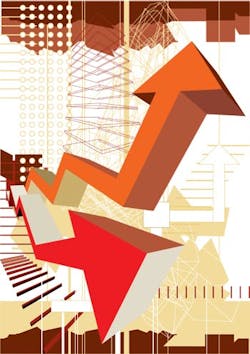There may be nothing exciting about the rate of rise, but any kind of rise is better than what we have gone through in the last year-and-a-half.Sometimes, it helps to think of the economy as a train, with different segments of the economy representing the different cars that make up the train. The engine is normally in front and the caboose traditionally brings up the rear; and so it is with the economy, as the financial indicators lead the way while nonresidential construction generally acts as the caboose. The chart pictures this train as of March. You will note that most of the economy is moving up in Phase A (recovery). It is particularly exciting to note that the Financial Benchmark is now in Phase B.Phase A Management Objectives should be in place for companies that tend to move in synch with the general economy. A key objective to consider is placing capital equipment orders. Buying the equipment in Phase A will be far cheaper than it will be during 2011-2012. A great deal of both new and used equipment is currently available at attractive prices. Lead times also tend to be short at this phase of the business cycle. Think about equipment needs in terms of supporting extensions into new markets and/or reducing the labor content of your product.Big-three topicsThere are three big topics for all readers to prepare for as we move through 2010 and later in 2011. Each will require planning, as they will impact our budgets, planning and cash generation through at least the next few years. Inflation is coming and we must start to prepare for that eventuality. Let’s review why we expect inflation: 1) the rapid expansion in the money supply; 2) past and projected increased demand for metals and other commodities, especially as the global recovery takes root; and 3) rising energy prices also due to global expansion, the green movement and a shift in the demand curve.Expect inflationary pressures to impact your business later this year and in 2011. This will cost you more in terms of inventory purchases, services purchased and labor costs. Figure out when you will be increasing prices and factor that into your business planning. Inflationary pressures also mean we should all lock in as many costs as possible for as long as possible.Interest rates can be expected to go up, owing to these inflationary pressures. Looming interest rate rise means we should all lock in rates soon, if we can, and prepare to face an increased cash drain later this year and in 2011 if we can’t lock in interest rates. This is a normal cyclical move, but it is one that most people have not thought about for 20 years. Now is the time to start planning for this increased cost to your business.Taxes make up the third item on our list. It is no secret that the United States is facing a mountain of debt, and that the budget shortfalls over the next 10 years are expected to add another $10 trillion to that debt. The options are fairly limited in that Congress can hope that inflation takes care of the problem (not likely), radically cut spending and/or increase taxes. This last option appears to be the most likely. The increased tax burden will inherently limit the cash available to you for reinvestment in your firms or for distribution as dividends.Alan Beaulieu, [email protected], is President of the Institute for Trend Research (www.ecotrends.org), in Boscawen, N.H.
Subscribe to Automation World's RSS Feeds for Columns & Departments
About the Author
Sign up for our eNewsletters
Get the latest news and updates

Leaders relevant to this article:
